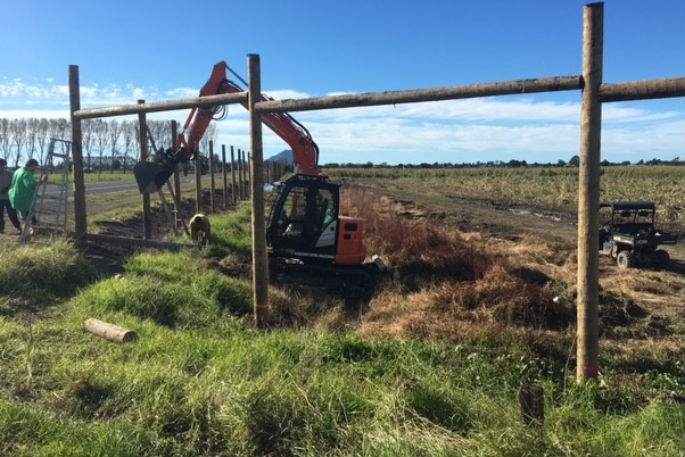The Bay of Plenty Regional Council wants to reassure the community that dust generated by the Kopeopeo Canal Remediation Project at a dioxin dumping site in Awakeri over the next few weeks is not contaminated.
BOPRC project manager Brendon Love says Containment Site One at the intersection of State Highway 30 and Kope Drain Road is currently marked with large fences and dust cloth.
'We know there are some significant concerns in the community about dust generated during the Project. The current works on the containment site are normal earthworks and we will be working hard to keep any dust to an absolute minimum, using water tankers on site and dust cloth.
'The dust monitoring that has been set up on-site since March will monitor compliance with consent conditions during this phase of work.”
During the dredging works later in the year, a cutter-section dredge will suck up sediment from the Kopeopeo Canal and transport it through a pipeline directly to the fully-lined containment site where it is treated prior to being pumped into special geotextile tubes.
The sediment will be de-watered and safely stored within the bags for bioremediation at a later date, says Brendon.
'This methodology was pursued in order to mitigate community concerns with spillage from trucks and dust generation as at no point in the transfer process is dry sediment exposed.”
April and May had been a busy months working with the contractors, EnviroWaste Ltd, to get the site ready.
'The changes at CS1 are the most significant physical works to date. We lost a bit of time during the recent big weather events and it has taken a while for ground-conditions to be dry enough to get machinery on site. But we are still on target to start dredging by late July.”
The work in and around Containment Site 1 will mean there are also speed restrictions in place along SH30 so heavy traffic can enter and leave Kope Drain Road safely.
'It may be a little disruptive for road users, but we appreciate everyone's patience so that we can keep local and site traffic safe.”
The $15.5 million project, will see up to 40,000m3 of contaminated sediment taken from the Canal and safely stored in two separate containment sites. The project is funded by the Ministry for the Environment's Contaminated Sites Remediation Fund and Bay of Plenty Regional Council,
The Project Team are also working towards an open day before dredging works start so the public can see the containment site controls, monitoring, and treatment process first hand.
'The trial site open day that we ran in 2015 was a huge success as it allowed the community to see for themselves what the final Project would look like, albeit in a smaller form.
'We would like to do the same again in the next few months before we start dredging, so that people can see the set up and what the site looks like to scale.”
The Bay of Plenty Regional Council's Rivers and Drainage Group is working with the community to clean up dioxin-contaminated sediment in the Kopeopeo Canal.
The canal was contaminated between the 1950s and late 1980s as a result of stormwater discharges from a former sawmill, which treated timber using Pentachlorophenol. While unknown at the time, PCP imported into New Zealand for use in the timber processing industry also included a percentage of impurities that contained dioxins.
The project will take a staged approach to remove, safely store and treat up to 40,000m3 of sediment.
Consent was granted for works to begin in 2014, subject to significant conditions. The community raised a number of concerns about the original methodology (excavators and trucks) for removal of the sediment.
Following a successful pilot study of a new method in October 2015, an application was lodged in May 2016 to vary the existing consent so that the sediment could be removed by a cutter suction dredge and transferred by pipeline to the containment sites.
This new method virtually eliminates the heavy traffic and potential for spillages and associated dust generation, and brings improvements to the containment site design which reduces potential groundwater and flooding related effects. The variation to the consent was approved in October 2016.



0 comments
Leave a Comment
You must be logged in to make a comment.